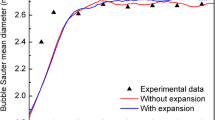Abstract
A three-dimensional mathematical model has been developed to simulate the fluid flow phenomena in gas-stirred ladles. It can predict the velocity profile and flow pattern of the liquid and the gas bubbles. The two-phase fluid flow phenomena were analyzed by using the SOLA-SURF technique supplemented with the K-e two-equation turbulence model. The interactions between the gas bubble motion and the liquid flow were also considered. The movements of the gas bubbles were calculated and the extent of the plume zone determined. The effects of various design/operation conditions, such as gas flow rate, location of the porous plug, and addition of an immersion hood, can be evaluated. Flow intensity and stirring ability increase with increased gas flow rate. The dead zone near the bottom corner of the ladle exists whether the porous plug is centered or off-centered; this problem only slightly improves when gas flow rate is increased. Addition of an immersion hood not only provides a slag-free and protective atmosphere inside the hood, but also reduces the dead zone.
Similar content being viewed by others
Abbreviations
- Cd :
-
drag factor
- D :
-
diffusivity
- De :
-
effective diffusivity
- Db :
-
bubble diameter
- F x F y , F z :
-
drag force by bubbles in the x, y, z direction. respectively
- g :
-
gravity
- H :
-
height of free surface
- K :
-
turbulence kinetic energy
- N :
-
total number of bubbles in a unit cell
- P :
-
pressure
- Q :
-
gas flow rate
- Re :
-
Reynolds number
- U, V, W:
-
velocity vector of the liquid in the
- x, y, z :
-
direction, respectively
- Ub, Vb, Wb :
-
velocity vector of the bubble in the
- x, y, z :
-
direction, respectively
- α1 :
-
void fraction of fluid
- αm :
-
void fraction of a bubble in a unit cell
- ε:
-
dissipation rate of turbulence energy
- pg :
-
density of gas
- P1 :
-
density of liquid
- ve :
-
effective kinematic viscosity
- μl :
-
viscosity of liquid
- vm :
-
molecular kinematic viscosity
- vt :
-
turbulence kinematic viscosity
References
L.E.K. Holappa, Review of Ladle Metallurgy, Proc. SCANINJECTII Conf., MEFOS, 1980, p 1:1–1:23
Y.C. Lin and F.S. Shih, “The Water Model Study of Gas-Stirring Ladle in Slag and Atmosphere Control Process,” Research report no. CSC-75-035, China Steel Corp., Kaohsiung, Taiwan, 1988
T. Harabuchi and K. Ohtsuka, Proc. Symp. Steel Production Technology, China Steel Corp., Kaohsiung, Taiwan, 1986, p 2A/8–1
J.D. Hwang, Y.C. Lin, and W.S. Hwang, Fluid Flow Modeling of Gas Stirred Ladles with Immersion Hood, Mater. Sci. Technol., Vol 6, 1990, p 376–382
J.F. Davidson and B.O.G. Schüler, Trans. Inst. Chem. Eng., Vol 38, 1960, p 144
B.E. Launder and D.B. Spalding, Mathematical Modeling of Turbulence, Academic Press, London, 1972
C.W. Hirt, B.D. Nichols, and N.C. Romero, “SOLA-SURF—Basic Solution Algorithm for Flows Bounded by Curved Surfaces,” Report no. LA-5852 (Part 2), Los Alamos Scientific Laboratory, 1975
C.W. Hirt, B.D. Nichols, and N.C. Romero, “SOLA—A Numerical Solution Algorithm for Transient Fluid Flows,” Report no. LA-5852 (Part 1), Los Alamos Scientific Laboratory, 1975
Author information
Authors and Affiliations
Rights and permissions
About this article
Cite this article
Pan, S.M., Ho, Y.H. & Hwang, W.S. Three-dimensional fluid flow model for gas-stirred ladles. J. of Materi Eng and Perform 6, 311–318 (1997). https://doi.org/10.1007/s11665-997-0095-z
Issue Date:
DOI: https://doi.org/10.1007/s11665-997-0095-z




